- Home
- Research
- Nanooptics
- Research results
- Clever folded: Manipulating light with origami
Clever folded: Manipulating light with origami

24.11.2023
A team of researchers – led by Leibniz IPHT in Jena – has succeeded in creating smart optical nanostructure designs that can guide and control the emission of light from single quantum emitters. The researchers are thus laying important foundations for the development of efficient photonic circuits that can be used, for example, in wireless optical communication. The scientists published their results in the renowned journal ACS Nano.
In order to create functional and nanoscopically small structures with defined properties, the so-called DNA origami technique can be used. With this technique, researchers are able to produce complex nanostructures by folding long DNA strains into a suitable three-dimensional framework to host metallic nanoparticles in the desired spatial arrangement. Driven by quantum emitters such as single dye molecules, the resulting hybrid nanostructures can ultimately be used as directional single-photon light sources in photonic nanocircuits that use light for signal processing. Their design allows to specifically control the propagation direction of the emitted photons.
In their latest research work, which they present in the journal ACS Nano, the Leibniz IPHT researchers developed an extremely compact meta-emitter with a size of less than 150 nanometers (about the size of a corona virus), thanks to the DNA origami fabrication technology. For this purpose, they combined three 60-nanometer spherical gold nanoparticles held together with the aid of a triangular DNA origami. A fluorescent dye molecule that emits the photons is smartly brought to the center of the gap between two gold nanoparticles by bending the DNA origami. This nanosized functional structure, also known as a nanoantenna, has the special property of being able to control the emitted light in a specific direction.
“Our method enables us to create a meta-emitter that allows unidirectional light emission, which is highly interesting for applications in quantum communication and wireless optical nanocircuits. We can influence the emission direction by, among other things, the shape and size of the gold nanoparticles and the position of the fluorophore. This allows us to precisely manipulate the emission properties and ensure that emitted photons do not propagate omnidirectional, but only in one direction,” explains Ayşe Tuğça Mina Yeşilyurt, first author of the paper and a PhD student in the Research Department Nanooptics at Leibniz IPHT.
The meta-emitter created by the scientists can not only significantly improve the emission directionality of the emitter, but also increase its brightness. In their experimental studies, the researchers were able to show that the plasmonic nanoantenna design can increase the emission 23 times – while at the same time reducing the footprint by at least five times compared to their previously realized Yagi-Uda nanoantennas. They are thus laying the foundations for increasing efficiency in wireless optical communication.
Scientific publication
The original idea of this work came from the stimulating discussions during Leibniz IPHT’s traditional Dornburg Seminar in 2017 between the investigators of the Research Departments of Nanooptics and Nanobiophotonics at Leibniz IPHT, who work on plasmonic unidirectional nanoantennas and DNA nanotechnology, respectively.
Together with the group led by Prof. Guillermo Acuna at the University of Fribourg, Switzerland, the researchers published their results in the renowned journal ACS Nano:
A. T. M. Yeşilyurt, M. Sanz-Paz, F. Zhu, X. Wu, K. Suma Sunil, G. P. Acuna, J.-S. Huang, Unidirectional Meta-Emitters Based on the Kerker Condition Assembled by DNA Origami, ACS Nano (2023), https://doi.org/10.1021/acsnano.3c05649
In the picture:
Ayşe Tuğça Mina Yeşilyurt, first author of the paper and a PhD student in the Research Department Nanooptics at Leibniz IPHT (left in the picture), and PD Dr. Jer-Shing Huang, Head of the Research Department Nanooptics (right in the picture)
